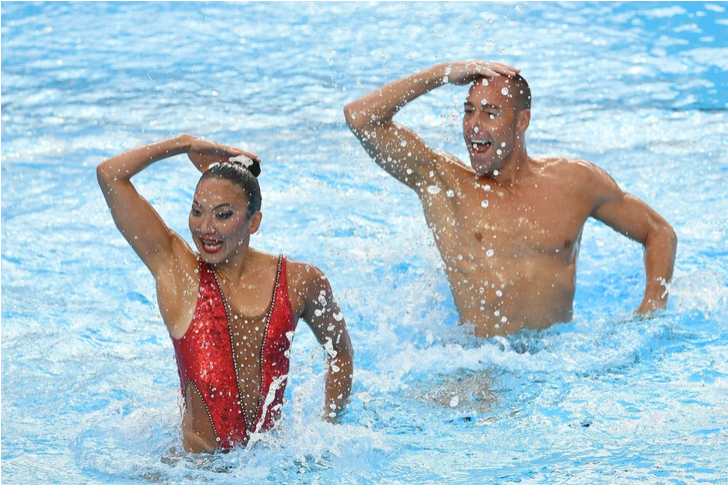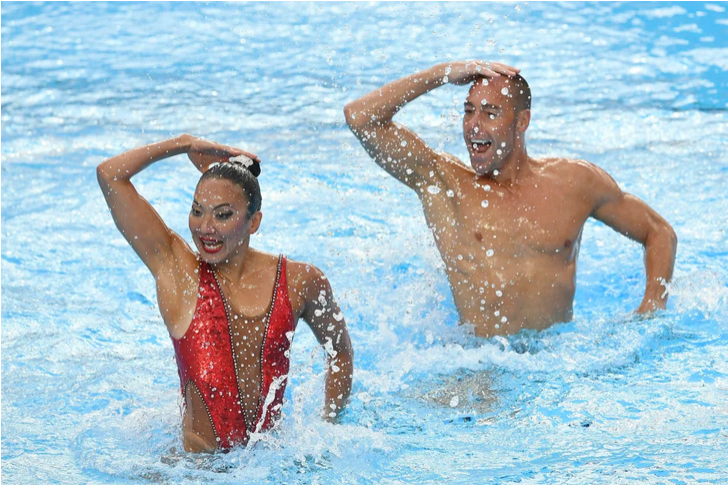Introduction
Artistic swimming, formerly known as synchronized swimming, is one of the most visually stunning sports in the Olympic Games. Combining the grace of ballet, the strength of gymnastics, and the endurance of long-distance swimming, this sport captivates audiences with its intricate routines and seamless synchronization.
Read More : Imane Khelif : Is there a hard line between men and women?
See More : https://heylink.me/sabrina-zahira
History of Artistic Swimming in the Olympics
Artistic swimming made its Olympic debut at the Los Angeles Games in 1984. Initially, it featured solo and duet events, but the solo competition was later dropped, and the team event was added. This shift highlighted the sport’s emphasis on group coordination and team dynamics.

The Elements of Artistic Swimming
- Choreography: The routines are meticulously planned and choreographed to showcase a blend of artistic and technical skills. Choreographers often draw inspiration from various dance forms, music styles, and thematic concepts.
- Music: Music is a crucial component, as routines are performed to musical accompaniment. The choice of music sets the tone and can vary from classical to contemporary genres.
- Costumes and Makeup: Swimmers wear elaborate costumes and waterproof makeup to enhance the visual appeal of their performances. These elements help to tell a story and add to the overall artistry.
- Technical Skills: Swimmers must master a range of techniques, including sculls (hand movements for propulsion), lifts, and synchronized movements. Precision and synchronization are critical, as even a minor error can impact the entire routine.
Training Regimen
Artistic swimmers undergo rigorous training that includes strength training, endurance exercises, flexibility routines, and countless hours in the pool. Their training regimen often involves ballet, gymnastics, and dance to develop the necessary coordination and body control.
Judging and Scoring
In artistic swimming, routines are scored based on technical execution, artistic impression, and difficulty. Judges look for synchronization, transitions, height in lifts, and the overall flow of the performance. The scoring system ensures that both technical prowess and artistic creativity are rewarded.
Memorable Olympic Moments
The Olympic stage has witnessed numerous breathtaking performances. Highlights include the Russian team’s dominance in recent years, known for their impeccable precision and innovative choreography. The sport has also seen emotional and inspiring moments, such as the duet performance of the Chinese twins, Jiang Wenwen and Jiang Tingting, who captivated audiences with their flawless routines.
The Future of Artistic Swimming
As the sport evolves, there is a growing emphasis on inclusivity and innovation. The introduction of mixed-gender teams in some competitions is a testament to this progress. Moreover, advancements in underwater technology and broadcast techniques are providing viewers with an immersive experience, allowing them to appreciate the complexity of the sport.
Conclusion
Artistic swimming is more than just a sport; it is a celebration of grace, strength, and creativity. Its presence in the Olympic Games not only showcases the athleticism of the swimmers but also the beauty of human movement and artistic expression. As the sport continues to grow and evolve, it promises to inspire and captivate audiences worldwide. Artistic Swimming in the Olympics: A Dance in Water

Pingback: Jaimy Vanenburg (32), dochter van oud-international Gerald, overleden - smartoobiz.com